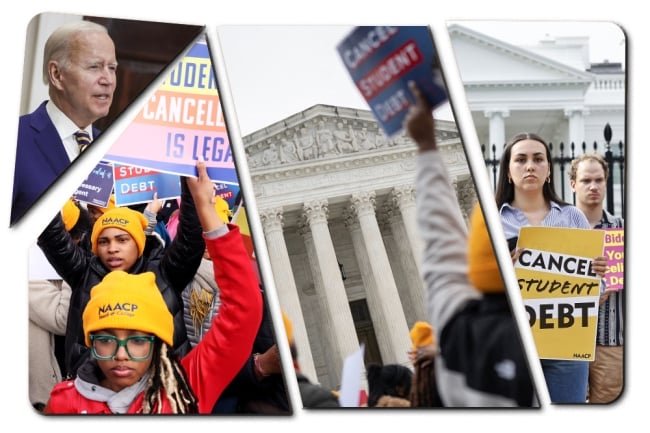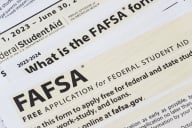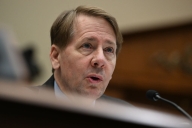You have /5 articles left.
Sign up for a free account or log in.

A year after President Biden said he would cancel up to $20,000 in student loans, borrowers still wait for relief. Advocates say Biden’s announcement was a landmark in the fight for debt cancellation even though the Supreme Court blocked his plan.
Photo illustration by Justin Morrison/Inside Higher Ed | Getty Images
A year ago today, President Biden stood in the Roosevelt Room of the White House and declared that his administration would cancel some or all of the student loan debt for 43 million Americans—a groundbreaking decision that kicked off a year of legal battles and fierce debates over student loan policy.
“An entire generation is now saddled with unsustainable debt in exchange for an attempt, at least, at a college degree,” Biden said. “The burden is so heavy that even if you graduate, you may not have access to the middle-class life that the college degree once provided.”
For advocates of debt relief, the announcement represented a hard-won victory, especially since the president had initially been skeptical of his ability to cancel student loans via executive action. For eligible borrowers, the announcement meant a lifeline before payments resumed following a three-year pandemic pause. For critics, particularly conservatives and congressional Republicans, the president’s decision was galling in its overreach and scale.
And yet, one year later, “borrowers are still really in the same place they were last August,” said Michelle Dimino, deputy director of education at Third Way, a center-left think tank that opposes broad-based cancellation. “They have nothing to show for the promise of forgiveness, and they have bills coming due soon.”
The Supreme Court blocked Biden’s debt-relief plan earlier this year, and the administration is now working on a backup plan to provide broad-based cancellation using its authority under the Higher Education Act of 1965 while rolling out separate efforts to make payments more affordable. Meanwhile, after more than three years, the federal government is requiring borrowers to restart making student loan payments. Interest will begin accruing on balances in September, and payments will be due starting in October.
“As long as I’m president, my administration will never stop fighting to deliver relief to borrowers and bring the promise of college to more Americans,” Biden vowed in a video statement earlier this week.
The legacy of Biden’s Roosevelt Room announcement is still unclear, given that the effort to provide mass debt relief is unfinished. But Dimino and others say that the president’s promise of broad-based debt cancellation shifted the conversation about student loans in a possibly permanent way. What was considered to be a fringe left-wing idea up until a few years ago has proven to be more politically potent than many expected and has shined a spotlight on the need for student loan reform. Over the past year, lawmakers on both sides of the aisle in the House and Senate, including staunch critics of Biden’s executive actions, have offered up plans to fix the system.
“It’s not necessarily an issue that can be swept under the rug, even if mass loan forgiveness is not the right remedy,” said Preston Cooper, a senior fellow at the Foundation for Research on Equal Opportunity, a market-friendly think tank. “While I don’t agree with the policy prescription of mass student loan forgiveness, I do think that these conversations can be a catalyst for thinking about broader reforms to the student loan system and how we can change the program to make it better work for students and taxpayers.”
Biden Student Loan Forgiveness Timeline
- Aug. 24, 2022: Biden unveils plan to forgive up $20K in student loans
- Oct. 21, 2022: Federal court blocks debt relief
- Nov. 22, 2022: Biden extends payment pause through June 2023
- Feb. 28, 2023: Supreme Court hears arguments on debt relief
- June 30, 2023: Supreme Court blocks debt relief; Biden announces new plan
For Dominique Baker, an associate professor of education policy at Southern Methodist University who supports debt cancellation, Biden’s initial decision showed that broad-based relief was possible. And the president’s shift from a skeptic to a champion who will likely make the issue central to his re-election campaign, she said, demonstrated the power of a more than decade-long campaign by scholars, borrowers and advocates to highlight the problem of student loan debt and fight for cancellation.
“I think it is important to laud the administration,” she said, “while at the same time lauding the people that helped the administration to come to this point, because this is not the point that they were at [in] early January of 2021.”
Baker said the fight over cancellation is connected to the Supreme Court’s decision to ban race-conscious admissions—which came a day before the debt-relief ruling—along with a drop in public funding for higher education and other issues. “We cannot separate the fact that the people that rely the most on student loans to go to college, that have the largest amounts of debt, who struggle the most in repayments, are Black people,” she said. “And I think that matters when we then think about why debt cancellation has not happened yet.”
‘Keep Moving Forward’
Melissa Byrne, executive director of We, the 45 Million, a campaign of student loan borrowers that works for debt cancellation and free college, said she and her fellow advocates will not stop fighting for debt cancellation and free college despite the Supreme Court’s decision and Congress’s reluctance to act.
“A lesson in this is that just because you have a very broken Supreme Court and a Congress that’s a complicated hot mess, it doesn’t mean you just give up and [don’t] work on doing things,” she said. “You need to just keep moving forward and climb over any obstacles and keep going.”
Byrne praised the administration’s recent efforts to provide debt relief, including an account adjustment for borrowers enrolled in income-driven repayment plans. As part of a plan announced more than a year ago, the department has gone back through borrowers’ accounts to give them credit for more payments. More than 800,000 borrowers who had been in repayment for more than 20 years had their loans discharged through the first round of that adjustment. That action canceled $39 billion of debt.
“People who are in their 40s, 50s and 60s and older went to bed drowning in debt and then woke up free,” Byrne said.
In addition to the account adjustment, the Biden administration also created a new income-driven repayment plan that will lower monthly payments for low-income borrowers and offer forgiveness sooner for those who borrowed less than $12,000.
Cooper described the administration’s approach as “throwing a lot of things at the wall to see what sticks. It’s a number of different policies that are really just aimed at getting as much loan cancellation out the door as possible,” he said. “There are certain cases in which students who have been defrauded by their institutions should get some form of relief, but I think what the Biden administration is doing goes well beyond righting those historic wrongs. I think that they are trying to enact as much loan cancellation as possible regardless of whether it is warranted or not.”
Congressional Republicans remain adamantly opposed to any form of broad-based cancellation, which they see as a “slap in the face” for those who didn’t go to college or who paid off their loans. They’ve attempted to block Biden’s debt-relief plan through resolutions and restrictions in budget bills. Lawmakers in the House and Senate also are planning to propose legislation to block the new income-driven repayment plan, Politico reported.
Still, in a recognition of the issue’s political resonance, House and Senate Republicans have offered their own ideas on how they would reform the student loan system and help borrowers. House Republicans have proposed a bill that would create one income-driven repayment plan for all borrowers and prevent excessive interest from accruing for distressed borrowers, among other changes. Senate Republicans’ plan requires college academic programs to meet certain benchmarks to access federal financial aid, and it would streamline repayment options and possibly limit graduate school borrowing, among other provisions.
Critics such as the Jobs Creator Network, which challenged Biden’s mass debt relief in federal court, say that broad-based cancellation and the new income-driven repayment plan fail to address the root causes of student debt, such as the cost of college. (The Biden administration is working on a separate effort to identify college programs that it says provide a low financial value to students.)
“Colleges have spent like drunken sailors on administrators and amenities and passed the costs off to students in higher costs,” Job Creators Network president Alfredo Ortiz said in a statement. “Republicans have proposed numerous reforms to rein in reckless colleges and get to the heart of the problem, but Democrats continue to ignore these solutions in favor of vote-buying bailouts.”
Restarting Payments and Other Priorities
After a year of bitter debates over student loan forgiveness, the focus has shifted toward getting millions of Americans to begin repaying their loans again. The administration is offering a 12-month on-ramp so that borrowers who can’t make payments will be spared the worst financial consequences, including default.
Braxton Brewington, press secretary for the Debt Collective, which seeks to abolish debts, said the restart of payments could resemble a slow car crash. “Resuming payments while you don’t have that [relief] is just unilaterally bad,” he said.
Dimino worries that the dueling messages about the effort to provide student loan forgiveness and the return to repayment puts borrowers in a precarious situation. “We’ve been concerned all along about how that impacts borrowers to have the rug pulled out from under them so many times as they’re making really huge financial decisions on how to manage the resources and be able to think about repayment,” she said.
The department has called restarting payments a “herculean” administrative task. The agency charged with overseeing the process is underfunded, which could further complicate the project. “It’s a really delicate tightrope for everybody involved to walk, and they have to do it in lockstep with each other, which is even harder,” Dimino said.
Dimino and others are also concerned that because debt cancellation has taken up a lot of the Education Department’s time and attention, efforts to update or implement other higher education rules will fall to the wayside.
“It is a one-time solution that itself does not impact the underlying issues of quality and accountability that plagued the higher education system and that led to so many student borrowers being saddled with unrepayable student loan debt,” she said.
The debates that were sparked by Biden’s announcement of his debt-cancellation plan last August have revealed a sharp partisan divide on the issue, with Republicans unilaterally opposed and most Democrats in support of the president. As the 2024 campaign progresses, student loan debt will be a focal point of higher education debates. “We also can expect that Biden is going to continue to elevate this issue and campaign on this issue,” Dimino said.
But while the political lines are clearer than ever, consensus is nowhere to be found. Polling from USA Today and Ipsos in May found that nearly half of Americans supported Biden’s debt-cancellation plan. But far more said they support making college more affordable in the first place. As Dimino noted, “It’s not an issue where you can even come close to pleasing everyone.”








